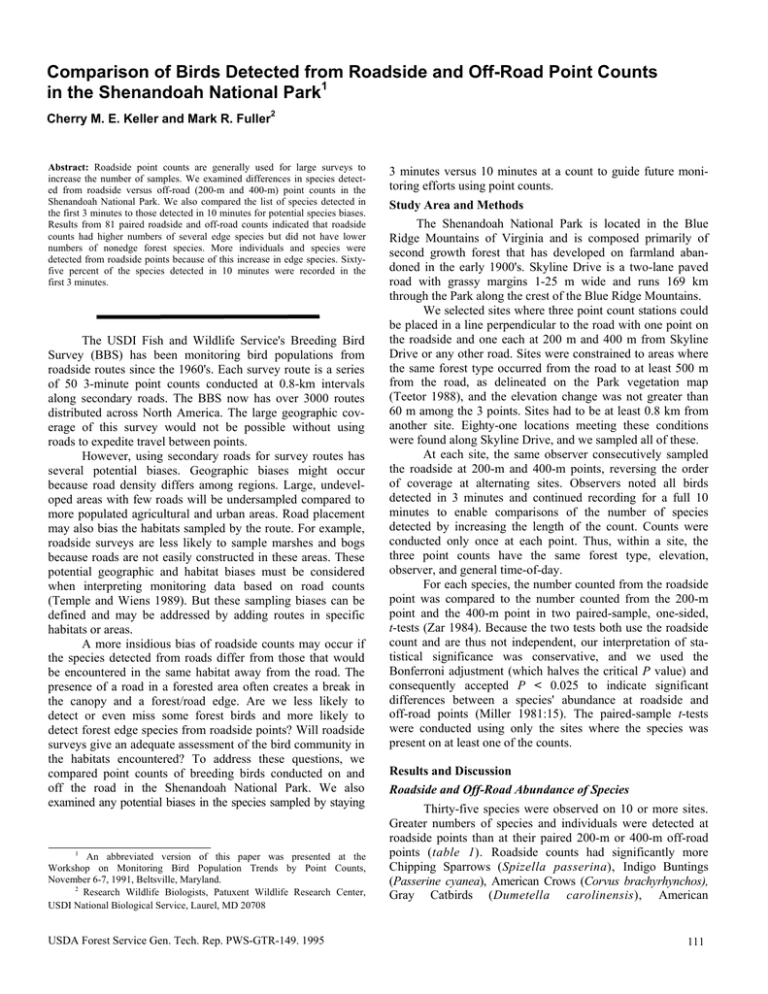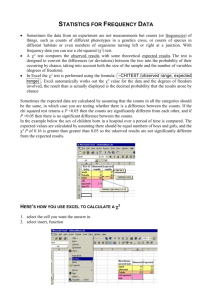Comparison of Birds Detected from Roadside and Off-Road Point Counts
advertisement

Comparison of Birds Detected from Roadside and Off-Road Point Counts in the Shenandoah National Park1 Cherry M. E. Keller and Mark R. Fuller2 Abstract: Roadside point counts are generally used for large surveys to increase the number of samples. We examined differences in species detected from roadside versus off-road (200-m and 400-m) point counts in the Shenandoah National Park. We also compared the list of species detected in the first 3 minutes to those detected in 10 minutes for potential species biases. Results from 81 paired roadside and off-road counts indicated that roadside counts had higher numbers of several edge species but did not have lower numbers of nonedge forest species. More individuals and species were detected from roadside points because of this increase in edge species. Sixtyfive percent of the species detected in 10 minutes were recorded in the first 3 minutes. The USDI Fish and Wildlife Service's Breeding Bird Survey (BBS) has been monitoring bird populations from roadside routes since the 1960's. Each survey route is a series of 50 3-minute point counts conducted at 0.8-km intervals along secondary roads. The BBS now has over 3000 routes distributed across North America. The large geographic coverage of this survey would not be possible without using roads to expedite travel between points. However, using secondary roads for survey routes has several potential biases. Geographic biases might occur because road density differs among regions. Large, undeveloped areas with few roads will be undersampled compared to more populated agricultural and urban areas. Road placement may also bias the habitats sampled by the route. For example, roadside surveys are less likely to sample marshes and bogs because roads are not easily constructed in these areas. These potential geographic and habitat biases must be considered when interpreting monitoring data based on road counts (Temple and Wiens 1989). But these sampling biases can be defined and may be addressed by adding routes in specific habitats or areas. A more insidious bias of roadside counts may occur if the species detected from roads differ from those that would be encountered in the same habitat away from the road. The presence of a road in a forested area often creates a break in the canopy and a forest/road edge. Are we less likely to detect or even miss some forest birds and more likely to detect forest edge species from roadside points? Will roadside surveys give an adequate assessment of the bird community in the habitats encountered? To address these questions, we compared point counts of breeding birds conducted on and off the road in the Shenandoah National Park. We also examined any potential biases in the species sampled by staying 1 An abbreviated version of this paper was presented at the Workshop on Monitoring Bird Population Trends by Point Counts, November 6-7, 1991, Beltsville, Maryland. 2 Research Wildlife Biologists, Patuxent Wildlife Research Center, USDI National Biological Service, Laurel, MD 20708 USDA Forest Service Gen. Tech. Rep. PWS-GTR-149. 1995 3 minutes versus 10 minutes at a count to guide future monitoring efforts using point counts. Study Area and Methods The Shenandoah National Park is located in the Blue Ridge Mountains of Virginia and is composed primarily of second growth forest that has developed on farmland abandoned in the early 1900's. Skyline Drive is a two-lane paved road with grassy margins 1-25 m wide and runs 169 km through the Park along the crest of the Blue Ridge Mountains. We selected sites where three point count stations could be placed in a line perpendicular to the road with one point on the roadside and one each at 200 m and 400 m from Skyline Drive or any other road. Sites were constrained to areas where the same forest type occurred from the road to at least 500 m from the road, as delineated on the Park vegetation map (Teetor 1988), and the elevation change was not greater than 60 m among the 3 points. Sites had to be at least 0.8 km from another site. Eighty-one locations meeting these conditions were found along Skyline Drive, and we sampled all of these. At each site, the same observer consecutively sampled the roadside at 200-m and 400-m points, reversing the order of coverage at alternating sites. Observers noted all birds detected in 3 minutes and continued recording for a full 10 minutes to enable comparisons of the number of species detected by increasing the length of the count. Counts were conducted only once at each point. Thus, within a site, the three point counts have the same forest type, elevation, observer, and general time-of-day. For each species, the number counted from the roadside point was compared to the number counted from the 200-m point and the 400-m point in two paired-sample, one-sided, t-tests (Zar 1984). Because the two tests both use the roadside count and are thus not independent, our interpretation of statistical significance was conservative, and we used the Bonferroni adjustment (which halves the critical P value) and consequently accepted P < 0.025 to indicate significant differences between a species' abundance at roadside and off-road points (Miller 1981:15). The paired-sample t-tests were conducted using only the sites where the species was present on at least one of the counts. Results and Discussion Roadside and Off-Road Abundance of Species Thirty-five species were observed on 10 or more sites. Greater numbers of species and individuals were detected at roadside points than at their paired 200-m or 400-m off-road points (table 1). Roadside counts had significantly more Chipping Sparrows (Spizella passerina), Indigo Buntings (Passerine cyanea), American Crows (Corvus brachyrhynchos), Gray Catbirds (Dumetella carolinensis), American 111 Comparison of Birds Detected from Roadside and Off-Road Point Counts Cherry M. E. Keller and Mark R. Fuller Table 1--Results of paired sample t-test comparing number of birds detected at roadside points to number detected at 200-m or 400-m off-road points. Analyses were conducted on the sites where the species was present on at least one of the 0-m, 200-m, or 400-m counts. Mean number per count is also calculated from these sites. Species are ordered by the ratio of roadside to off-road mean abundance. x Number/count if species present Species Chipping Sparrow (Spizella passerina) American Robin (Turdus migratorius) Indigo Bunting (Passerina cyanea) American Crowa (Corvus brachyrhynchos) Chimney Swift (Chaetura pelagica) Gray Catbird (Dumetella carolinensis) Chestnut-sided Warbler (Dendroica pensylvanica) Common Raven (Corvus corax) American Goldfinch (Carduelis tristis) Brown-headed Cowbird (Molothrus ater) Northern Cardinal (Cardinalis cardinalis) Cerulean Warblera (Dendroica cerulea) Pileated Woodpeckera (Dryocopus pileatus) Wood Thrusha (Hylocichla mustelina) Tufted Titmousea (Parus bicolor) Dark-eyed Junco (Junco hyemalis) Red-eyed Vireoa (Vireo olivaceous) Great Crested Flycatchera (Myiarchus crinitus) Solitary Vireo (Vireo solitarius) Ovenbirda (Seiurus aurocapillus) Scarlet Tanagera (Piranga olivacea) American Redstarta (Setophaga ruticilla) Blue Jay (Cyanocitta cristata) Yellow-billed Cuckoo (Coccyzus americanus) Eastern Wood-Pewee (Contopus virens) Rufous-sided Towhee (Pipilo erythrophthalmus) Downy Woodpecker (Picoides pubescens) Red-bellied Woodpeckera (Melanerpes carolinensis) Veerya (Catharus fuscescens) 0m 1.36 200 m 0.16 13 1.23 0.23 0.31 0.02 * 0.08 4.56 65 1.78 0.58 0.60 0.00 * 0.00 * 3.02 26 1.11 0.34 0.42 0.01 * 0.00 * 2.92 11 0.73 0.09 0.45 0.13 0.57 2.70 20 1.15 0.40 0.50 0.02 * 0.05 2.56 21 1.00 0.42 0.52 0.04 0.14 2.13 38 0.79 0.50 0.32 0.11 0.01 * 1.93 36 0.64 0.25 0.50 0.01 * 0.42 1.71 40 0.82 0.40 0.58 0.03 0.29 1.67 10 0.90 0.90 0.20 1.00 0.88 1.64 18 0.78 0.44 0.56 0.30 0.46 1.56 23 0.65 0.39 0.52 0.28 0.61 1.43 62 1.13 1.05 0.74 0.59 0.02 * 1.26 32 0.81 0.56 0.75 0.16 0.75 1.24 24 0.62 0.42 0.62 0.28 1.00 1.19 64 1.27 1.06 1.09 0.19 0.29 1.18 27 0.56 0.48 0.55 0.70 1.00 1.09 38 0.68 0.68 0.58 1.00 0.61 1.08 60 1.13 0.98 1.17 0.37 0.87 1.05 76 0.88 0.89 0.91 0.91 0.85 0.98 49 1.00 1.00 1.06 1.00 0.75 0.97 19 0.42 0.26 0.63 0.33 0.33 0.94 30 0.53 0.60 0.53 0.66 1.00 0.94 76 0.93 1.04 0.97 0.46 0.78 0.93 72 1.08 1.21 1.14 0.51 0.78 0.92 25 0.44 0.56 0.44 0.65 1.00 0.88 10 0.40 0.30 0.70 0.68 0.34 0.80 40 1.42 1.77 1.92 0.13 0.10 0.77 400 m 0.20 0-200 m P 0.00 * 0-400 m P 0.00 * Ratio of road/off-road abundance 7.56 Number sites species present 25 continued 112 USDA Forest Service Gen. Tech. Rep. PSW-GTR-149. 1995 Comparison of Birds Detected from Roadside and Off-Road Point Counts Cherry M. E. Keller and Mark R. Fuller Table 1--continued x Number/count if species present Species Carolina Chickadee (Parus carolinensis) Acadian Flycatchera (Empidonax virescens) White-breasted Nuthatcha (Sitta carolinensis) Black-and-white Warblera (Mniotilta varia) Hooded Warblera (Wilsonia citrina) Rose-breasted Grosbeaka (Pheucticus ludovicianus) Number of species Number of individuals a 0-200 m P 0.37 0-400 m P 0.57 Ratio of road/off-road abundance 0.67 Number sites species present 20 0m 0.40 200 m 0.65 400 m 0.55 25 0.52 0.68 0.88 0.41 0.14 0.67 44 0.48 0.61 0.82 0.44 0.08 0.67 11 0.27 0.34 0.54 0.55 0.27 0.61 21 0.43 0.57 0.90 0.42 0.08 0.59 27 0.33 0.52 0.78 0.34 0.03 0.51 81 81 9.53 14.50 8.31 11.67 8.51 12.30 0.00 * 0.00 * 0.01 * 0.00 * 1.13 1.21 Considered to be area-sensitive (Robbins and others 1989). * P < 0.025 and considered statistically significant. Goldfinches (Carduelis tristis), and American Robins (Turdus migratorius) than paired counts 200 m from the road. Mean abundance of Chipping Sparrows on roadside points was over seven times the mean of its abundance at paired off-road points (table 1). The Common Raven (Corvus corax) and Wood Thrush (Hylocichla mustelina) were significantly more abundant on roadside points compared to 400-m points, but not compared to 200-m points. No species had a significantly greater abundance on off-road points than on the roadside point. Several area-sensitive species (Robbins and others 1989:25) were among those with the lowest roadside to off-road change in mean abundance (e.g., Rose-breasted Grosbeak (Pheucticus ludovicianus) and Hooded Warbler (Wilsonia citrina)), but their roadside abundance was not significantly lower than either off-road estimate. Thirty-three species were present on fewer than 10 sites. Total numbers of these rare or incidental species were also highest on the roadside points. Roadside points detected 25 of these 33 rare species, 21 of 33 were detected on 200-m points and 17 of 33 were detected on 400-m points. Thus, the major difference between roadside and off-road counts was the increased abundance of some species that are generally associated with forest edges, such as Indigo Buntings, and species associated with the grassy strip adjacent to the road such as Chipping Sparrows and robins. This increased count of edge species resulted in more species and more individuals detected from roadside points than off-road points. However, no species that are considered area-sensitive (Robbins and others 1989:25) were counted in significantly lower numbers from roads than from 200 m or 400 m off the road. Increased abundance along the road could also result from increased visibility along roads (Hutto, in this volume). While sighting distances would be required to evaluate this possibility, we feel this is not a major explanation of our USDA Forest Service Gen. Tech. Rep. PSW-GTR-149. 1995 results, simply because most of our detections were by sound and we would expect visibility to enhance detection of many species, not just those associated with edges. Roadside samples with large counts of edge species, or even small counts of other species, do not necessarily pose a problem for temporal population monitoring, provided an adequate sample of sites and counts of each species can be obtained. Where the same route is covered year after year, data can provide an index to population trends, if we assume that counts are related to population size and that population parameters are not influenced by the road. Roadside and Off-Road Assessment of Avian Community Although point counts have no adjustments for different detectabilities among species, land managers are likely to use point counts to assess the distribution of species in an area, and to provide rough estimates of the avian community on the property they manage. The high counts of edge species from roadsides will require some interpretation in describing the avian community from road counts. For example, roadside counts suggest Indigo Buntings are the most widely distributed species, occurring on 74 percent of the sites (table 2). However, off-road, they are ninth in abundance, occurring on 36 percent of the sites. Their distribution and dominance in the avian community is exaggerated in the roadside sample. There is some suggestion that the distribution of the Veery (Catharus fuscescens) is underestimated from the roadside sample. However, with these exceptions, the roadside sample actually provided a fairly similar assessment of species occurrence. Twelve of the 15 most common species found in the 400-m sample were among the 15 most common roadside species (table 2). And the same set of species occurred in 200-m and 400-m samples as the nine most common species on the roadside. Managers must realize that a few edge 113 Comparison of Birds Detected from Roadside and Off-Road Point Counts Cherry M. E. Keller and Mark R. Fuller Table 2--Fifteen species most frequently encountered in 81 point counts conducted 0 m, 200 m, and 400 m from the roadside, and the percentage of the 81 counts in which they occurred Frequent species at 0 m Indigo Bunting Percent 74 200 m Eastern Wood-Pewee 400 m 66 Eastern Wood-Pewee Percent 64 Scarlet Tanager 66 Scarlet Tanager 64 Scarlet Tanager 56 Eastern Wood-Pewee 64 Rufous-sided Towhee 58 Red-eyed Vireo 53 Red-eyed Vireo 59 Wood Thrush 56 Rufous-sided Towhee 53 Wood Thrush 57 Red-eyed Vireo 54 Ovenbird 51 Rufous-sided Towhee 54 Ovenbird 49 Wood Thrush 44 Ovenbird 48 American Redstart 42 Veery 42 American Redstart 44 Veery 42 American Redstart 40 Veery 28 Indigo Bunting 36 Indigo Bunting 36 Chipping Sparrow 28 Solitary Vireo 26 American Goldfinch 22 Brown-headed Cowbird 27 White-breasted Nuthatch 26 Brown-headed Cowbird 22 Common Raven 27 Yellow-billed Cuckoo 21 Rose-breasted Grosbeak 22 Tufted Titmouse 27 Common Raven 18 Acadian Flycatcher 21 American Goldfinch 25 Brown-headed Cowbird 17 Solitary Vireo 21 American Crow 23 Acadian Flycatcher 17 Tufted Titmouse 20 species will be widely distributed along roads but not as prevalent throughout large forested areas of the Park, while the occurrence of most species will be similar from roadside and off-road samples. Three- Versus l0-Minute Counts The mean number of species detected on a point count increased from 5.7 to 8.8 in counts of 3 and 10 minutes (n = 282 counts); thus approximately 65 percent of the species are detected within the first 3 minutes. Species varied in the likelihood of being detected in the first 3 minutes (table 3). Most species were detected in the first 3 minutes on 50 percent or more of the counts. Those most likely to be detected in the first 3 minutes were abundant, vocal species with small territories such as the Rufous-sided Towhee (Pipilo erythropthalmus), Wood Thrush, and Veery. Six species were missed in the first 3 minutes on more than 50 percent of the counts (table 3). These include less common or less vocal species with larger territories such as the Blue Jay (Cyanocitta cristata) and Brown-headed Cowbird (Molothrus ater). We expect to count more species with longer counts (Scott and Ramsey 1981), but it is important to recognize that length of count will influence the detection of some species more than others. Rarer and more cryptic species are less apt to be detected in shorter counts, and some differences appear even between 3- and 10-minute counts. Species with very low detectability may require special survey methods. As an example, we note that raptors were among those species detected on fewer than 10 sites. Raptors are known to have relatively low detection rates in eastern deciduous forests and they require special survey methods (Geissler and Fuller 1986, Mosher and others 1990). 114 Percent Conclusions These results suggest that biologists conducting roadside counts of birds are able to detect species that would be counted from points 200 m or 400 m from the road in the same habitat type. However, a greater number of species and greater abundance of many edge species will also be counted at the roadside. Most of these edge species had significantly lower abundance 200 m away from the road, suggesting they did not use forested areas very far from the forest edge. These differences should not impair our ability to monitor populations over time, but greater abundance of edge species at roadsides could influence assessments of the species composition of the avian community. Our results revealed that a greater number of species are detected if the count lasts 10 minutes rather than a shorter period. However, there were no apparent differences in the time required to detect edge species or area-sensitive species. Therefore, we suggest that the duration of the counts be based on efficiency (Verner 1988), number of sample points and, of course, objective. If the objective is to learn about the occurrence of all species on sample sites in a study area, more time should be spent at the site to increase the likelihood of seeing or hearing species with low probabilities of detection. If objectives emphasize the use of counts to monitor population trends of more common species, then sample size and the potential of counting individuals more than once become more important considerations (Verner 1988). This study was conducted in the middle of a very large block of forest where area-sensitive species were abundant and the roadside edge was one of the few forest openings in the area (Robbins and others 1989). In this setting, where for- USDA Forest Service Gen. Tech. Rep. PSW-GTR-149. 1995 Comparison of Birds Detected from Roadside and Off-Road Point Counts Cherry M. E. Keller and Mark R. Fuller Table 3--Proportion of counts where a species was detected in the last 7 minutes (missed in first 3 minutes), for species detected on at least 20 point counts Counts where species was Number of 10 minute counts Species where species was detected Blue Jay Brown-headed Cowbird American Goldfinch Yellow-billed Cuckoo Great Crested Flycatcher Rose-breasted Grosbeak a Downy Woodpecker Gray Catbird Carolina Chickadee White-breasted Nuthatch a Pileated Woodpeckera Chestnut-sided Warbler Cerulean Warbler a Hooded Warbler a Tufted Titmouse a Common Raven Solitary Vireo American Crow a Dark-eyed Junco Scarlet Tanagera Ovenbird a Acadian Flycatcher a Red-eyed Vireo a American Redstart a Indigo Bunting Eastern W o o d - P e w e e Veery a Wood Thrush a Chipping Sparrow Rufous-sided Towhee a 25 61 51 53 40 42 32 29 27 78 32 29 33 36 58 54 66 43 38 176 143 54 161 129 127 181 114 149 31 146 detected in last seven minutes Number Percent 17 37 29 29 21 22 16 14 13 37 15 13 14 15 24 22 24 13 11 50 40 15 41 32 31 43 26 33 6 28 68 61 57 55 53 52 50 48 48 47 47 45 42 42 41 41 36 30 29 28 28 28 25 25 24 24 23 22 19 19 Considered to be area-sensitive (Robbins and others 1989) est habitat is abundant, 10-m to 35-m openings in the forest were not avoided by area-sensitive birds, and the openings are sufficient to attract several edge species. In this situation, point counts from roadsides were as useful for detecting many forest dwelling birds as were counts 200 m and 400 m from the road. The generality of these results is being investigated at five other forested study areas where habitat types are more patchy than in Shenandoah National Park. USDA Forest Service Gen. Tech. Rep. PSW-GTR-149. 1995 Acknowledgments We thank David Holmes, Sue Riccardi, and Bob Dixon for their work in conducting surveys and acknowledge the cooperation and assistance of all the staff at Shenandoah National Park. Susan Klugman contributed to data analysis. Helpful comments on this manuscript were contributed by Deanna Dawson, Jeff Hatfield, and Mike Erwin. 115





